Taxation Law Assignment: Income Tax, CGT, and Fringe Benefits
VerifiedAdded on 2021/05/31
|8
|1915
|44
Homework Assignment
AI Summary
This taxation law assignment addresses several key issues, including whether payments received by Hilary are taxable income from personal exertion, the calculation of car fringe benefits, the tax implications of a loan and interest, and the application of capital gains tax (CGT). The solution analyzes these scenarios based on relevant sections of the ITAA 1997 and the Fringe Benefits Tax Assessment Act 1986, as well as case law such as Brent v. Federal Commissioner of Taxation. The assignment explores the distinction between capital receipts and income, the determination of taxable values for fringe benefits, and the tax treatment of loans and gifts. Furthermore, it covers CGT calculations, including the application of the indexation and discount methods, considering different scenarios such as the sale of property at market value and the implications of selling to a related party. The assignment provides detailed analysis and calculations, supported by references to relevant legislation and case law.
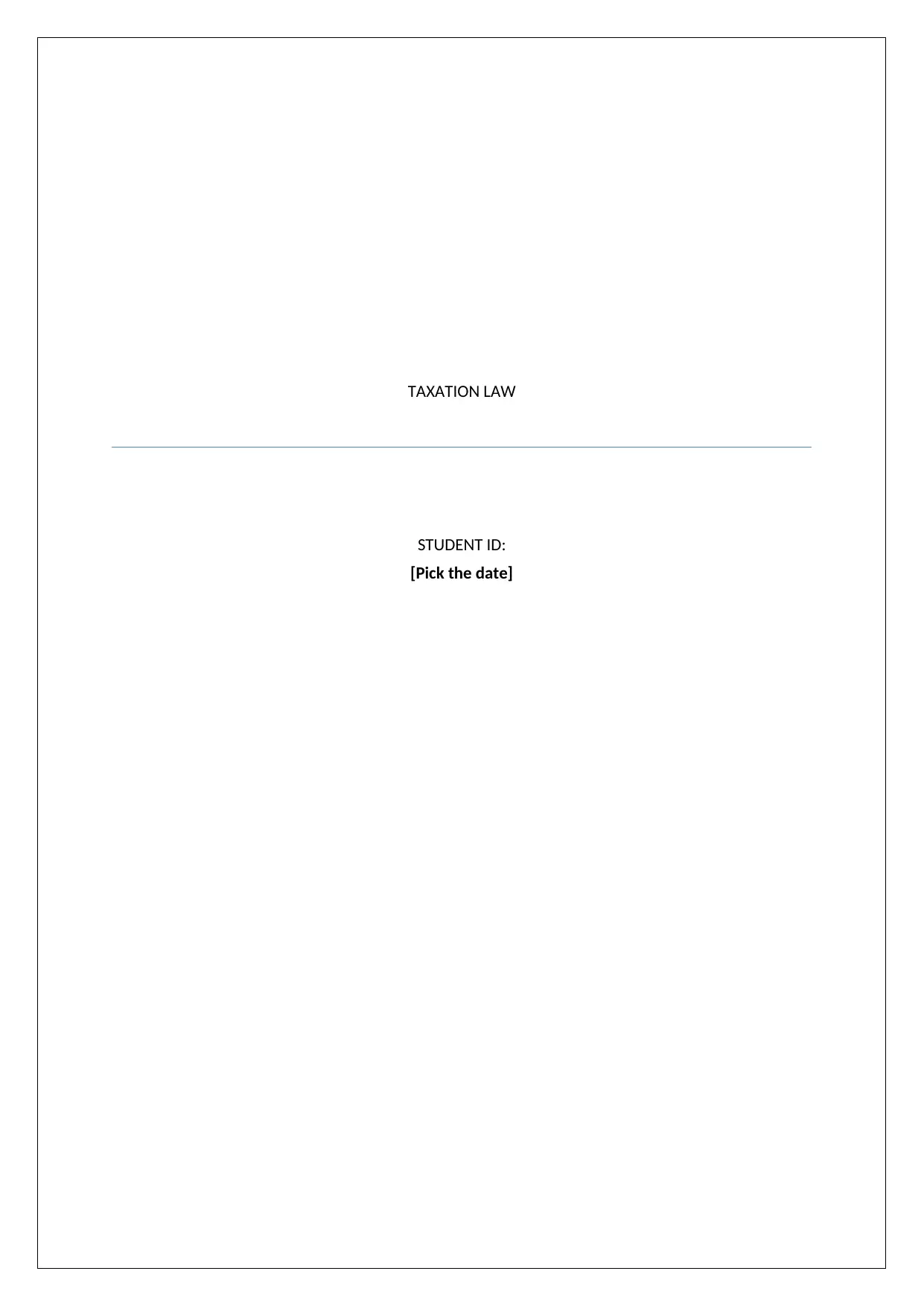
TAXATION LAW
STUDENT ID:
[Pick the date]
STUDENT ID:
[Pick the date]
Paraphrase This Document
Need a fresh take? Get an instant paraphrase of this document with our AI Paraphraser
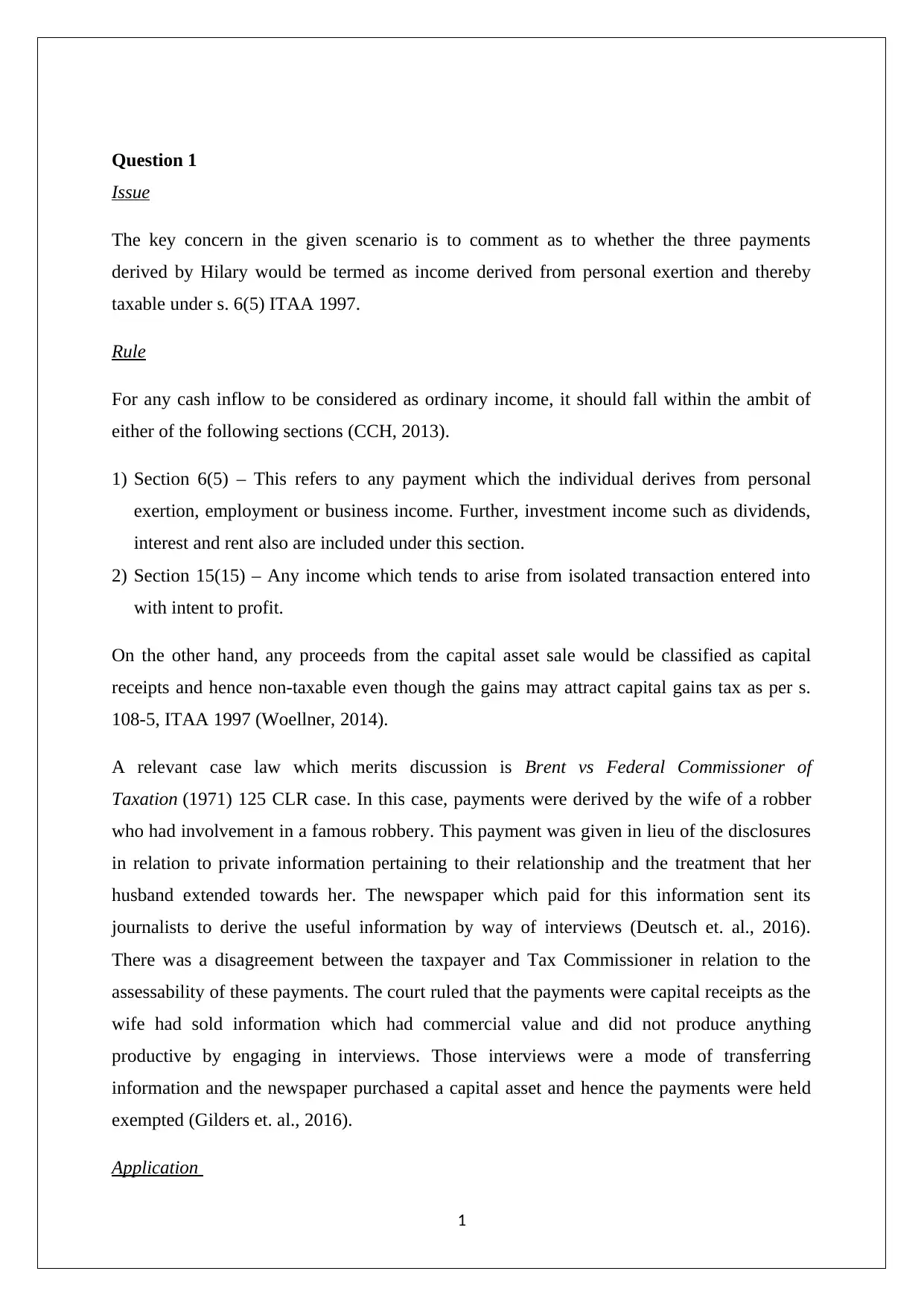
Question 1
Issue
The key concern in the given scenario is to comment as to whether the three payments
derived by Hilary would be termed as income derived from personal exertion and thereby
taxable under s. 6(5) ITAA 1997.
Rule
For any cash inflow to be considered as ordinary income, it should fall within the ambit of
either of the following sections (CCH, 2013).
1) Section 6(5) – This refers to any payment which the individual derives from personal
exertion, employment or business income. Further, investment income such as dividends,
interest and rent also are included under this section.
2) Section 15(15) – Any income which tends to arise from isolated transaction entered into
with intent to profit.
On the other hand, any proceeds from the capital asset sale would be classified as capital
receipts and hence non-taxable even though the gains may attract capital gains tax as per s.
108-5, ITAA 1997 (Woellner, 2014).
A relevant case law which merits discussion is Brent vs Federal Commissioner of
Taxation (1971) 125 CLR case. In this case, payments were derived by the wife of a robber
who had involvement in a famous robbery. This payment was given in lieu of the disclosures
in relation to private information pertaining to their relationship and the treatment that her
husband extended towards her. The newspaper which paid for this information sent its
journalists to derive the useful information by way of interviews (Deutsch et. al., 2016).
There was a disagreement between the taxpayer and Tax Commissioner in relation to the
assessability of these payments. The court ruled that the payments were capital receipts as the
wife had sold information which had commercial value and did not produce anything
productive by engaging in interviews. Those interviews were a mode of transferring
information and the newspaper purchased a capital asset and hence the payments were held
exempted (Gilders et. al., 2016).
Application
1
Issue
The key concern in the given scenario is to comment as to whether the three payments
derived by Hilary would be termed as income derived from personal exertion and thereby
taxable under s. 6(5) ITAA 1997.
Rule
For any cash inflow to be considered as ordinary income, it should fall within the ambit of
either of the following sections (CCH, 2013).
1) Section 6(5) – This refers to any payment which the individual derives from personal
exertion, employment or business income. Further, investment income such as dividends,
interest and rent also are included under this section.
2) Section 15(15) – Any income which tends to arise from isolated transaction entered into
with intent to profit.
On the other hand, any proceeds from the capital asset sale would be classified as capital
receipts and hence non-taxable even though the gains may attract capital gains tax as per s.
108-5, ITAA 1997 (Woellner, 2014).
A relevant case law which merits discussion is Brent vs Federal Commissioner of
Taxation (1971) 125 CLR case. In this case, payments were derived by the wife of a robber
who had involvement in a famous robbery. This payment was given in lieu of the disclosures
in relation to private information pertaining to their relationship and the treatment that her
husband extended towards her. The newspaper which paid for this information sent its
journalists to derive the useful information by way of interviews (Deutsch et. al., 2016).
There was a disagreement between the taxpayer and Tax Commissioner in relation to the
assessability of these payments. The court ruled that the payments were capital receipts as the
wife had sold information which had commercial value and did not produce anything
productive by engaging in interviews. Those interviews were a mode of transferring
information and the newspaper purchased a capital asset and hence the payments were held
exempted (Gilders et. al., 2016).
Application
1
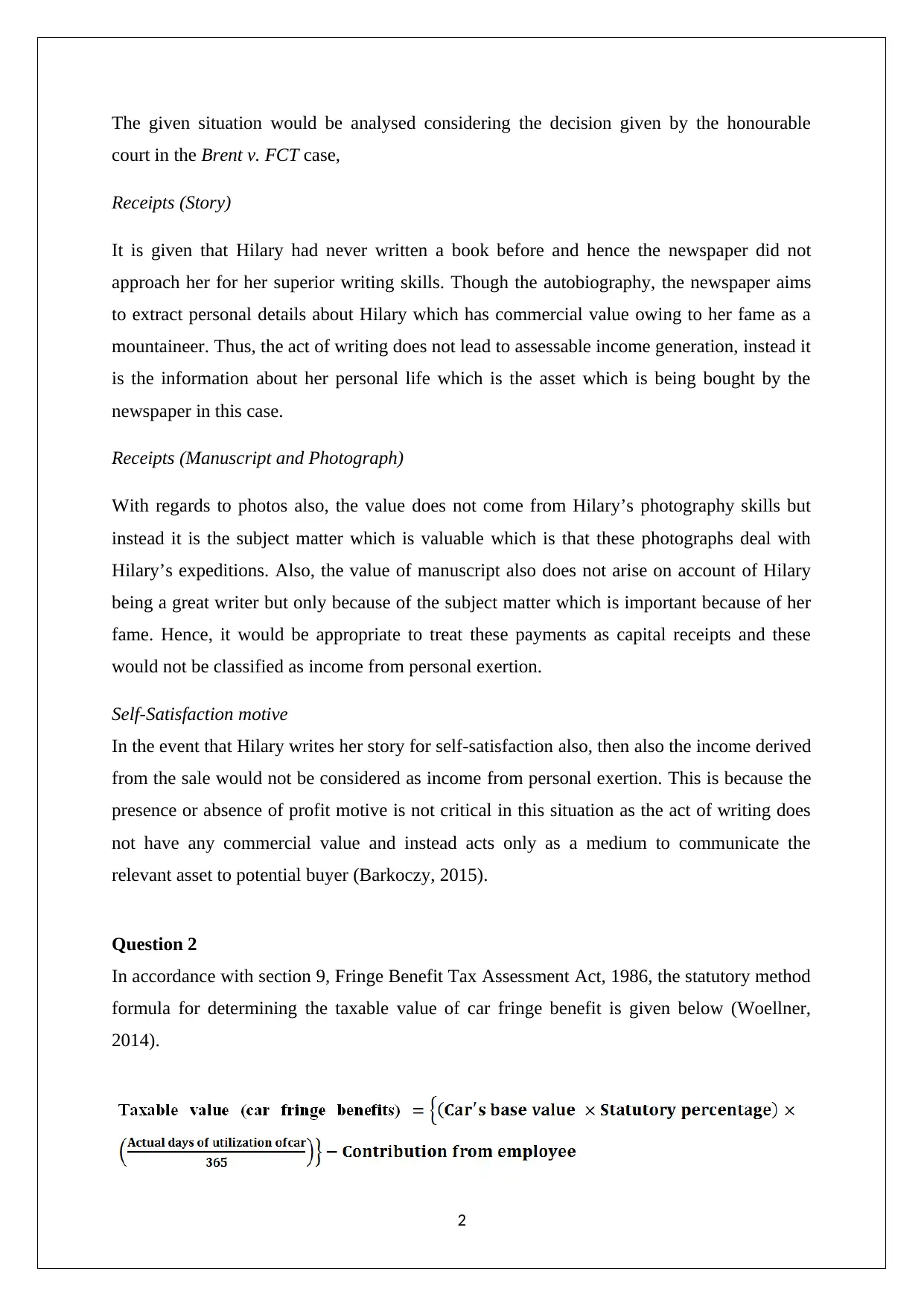
The given situation would be analysed considering the decision given by the honourable
court in the Brent v. FCT case,
Receipts (Story)
It is given that Hilary had never written a book before and hence the newspaper did not
approach her for her superior writing skills. Though the autobiography, the newspaper aims
to extract personal details about Hilary which has commercial value owing to her fame as a
mountaineer. Thus, the act of writing does not lead to assessable income generation, instead it
is the information about her personal life which is the asset which is being bought by the
newspaper in this case.
Receipts (Manuscript and Photograph)
With regards to photos also, the value does not come from Hilary’s photography skills but
instead it is the subject matter which is valuable which is that these photographs deal with
Hilary’s expeditions. Also, the value of manuscript also does not arise on account of Hilary
being a great writer but only because of the subject matter which is important because of her
fame. Hence, it would be appropriate to treat these payments as capital receipts and these
would not be classified as income from personal exertion.
Self-Satisfaction motive
In the event that Hilary writes her story for self-satisfaction also, then also the income derived
from the sale would not be considered as income from personal exertion. This is because the
presence or absence of profit motive is not critical in this situation as the act of writing does
not have any commercial value and instead acts only as a medium to communicate the
relevant asset to potential buyer (Barkoczy, 2015).
Question 2
In accordance with section 9, Fringe Benefit Tax Assessment Act, 1986, the statutory method
formula for determining the taxable value of car fringe benefit is given below (Woellner,
2014).
2
court in the Brent v. FCT case,
Receipts (Story)
It is given that Hilary had never written a book before and hence the newspaper did not
approach her for her superior writing skills. Though the autobiography, the newspaper aims
to extract personal details about Hilary which has commercial value owing to her fame as a
mountaineer. Thus, the act of writing does not lead to assessable income generation, instead it
is the information about her personal life which is the asset which is being bought by the
newspaper in this case.
Receipts (Manuscript and Photograph)
With regards to photos also, the value does not come from Hilary’s photography skills but
instead it is the subject matter which is valuable which is that these photographs deal with
Hilary’s expeditions. Also, the value of manuscript also does not arise on account of Hilary
being a great writer but only because of the subject matter which is important because of her
fame. Hence, it would be appropriate to treat these payments as capital receipts and these
would not be classified as income from personal exertion.
Self-Satisfaction motive
In the event that Hilary writes her story for self-satisfaction also, then also the income derived
from the sale would not be considered as income from personal exertion. This is because the
presence or absence of profit motive is not critical in this situation as the act of writing does
not have any commercial value and instead acts only as a medium to communicate the
relevant asset to potential buyer (Barkoczy, 2015).
Question 2
In accordance with section 9, Fringe Benefit Tax Assessment Act, 1986, the statutory method
formula for determining the taxable value of car fringe benefit is given below (Woellner,
2014).
2
⊘ This is a preview!⊘
Do you want full access?
Subscribe today to unlock all pages.

Trusted by 1+ million students worldwide
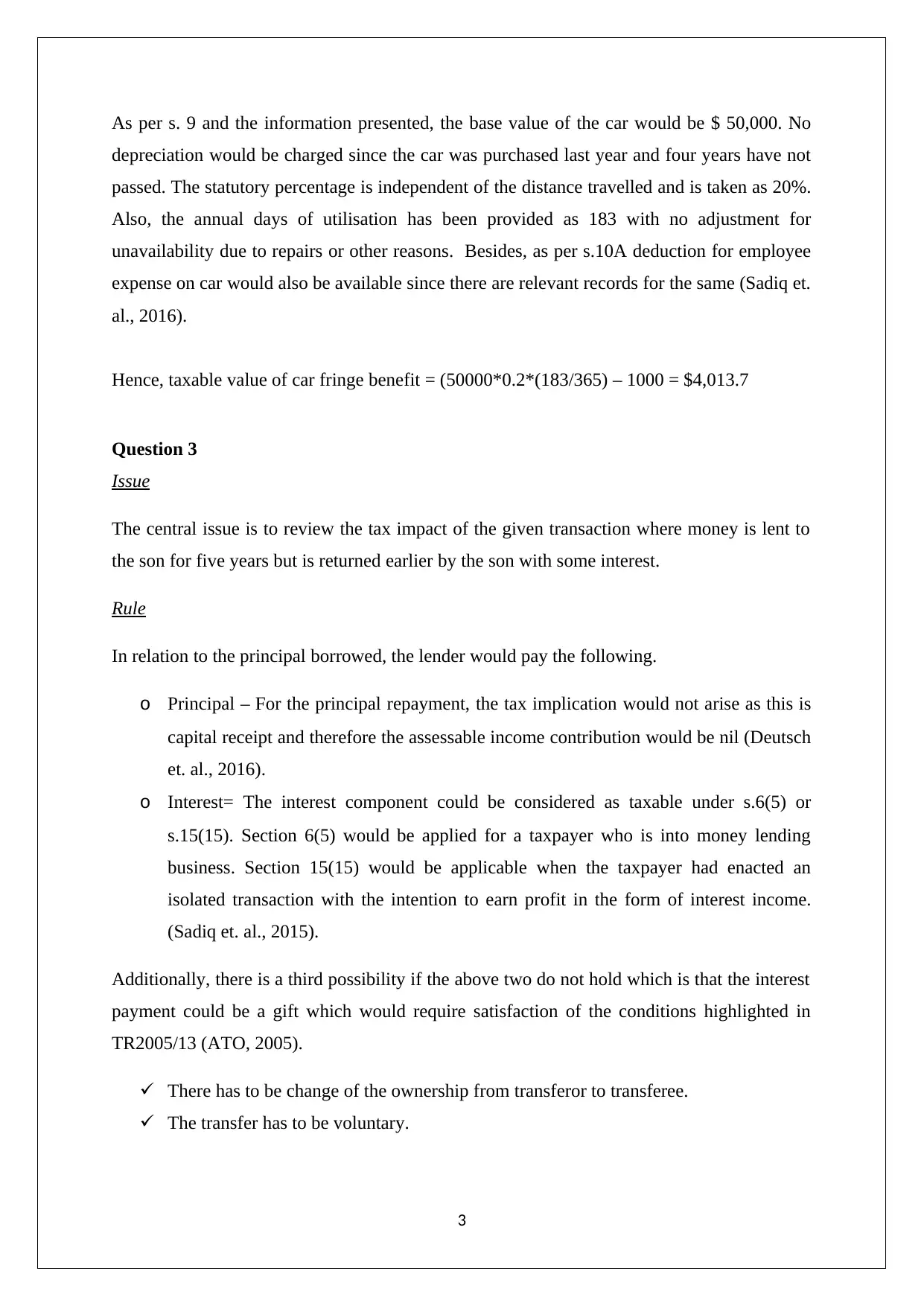
As per s. 9 and the information presented, the base value of the car would be $ 50,000. No
depreciation would be charged since the car was purchased last year and four years have not
passed. The statutory percentage is independent of the distance travelled and is taken as 20%.
Also, the annual days of utilisation has been provided as 183 with no adjustment for
unavailability due to repairs or other reasons. Besides, as per s.10A deduction for employee
expense on car would also be available since there are relevant records for the same (Sadiq et.
al., 2016).
Hence, taxable value of car fringe benefit = (50000*0.2*(183/365) – 1000 = $4,013.7
Question 3
Issue
The central issue is to review the tax impact of the given transaction where money is lent to
the son for five years but is returned earlier by the son with some interest.
Rule
In relation to the principal borrowed, the lender would pay the following.
o Principal – For the principal repayment, the tax implication would not arise as this is
capital receipt and therefore the assessable income contribution would be nil (Deutsch
et. al., 2016).
o Interest= The interest component could be considered as taxable under s.6(5) or
s.15(15). Section 6(5) would be applied for a taxpayer who is into money lending
business. Section 15(15) would be applicable when the taxpayer had enacted an
isolated transaction with the intention to earn profit in the form of interest income.
(Sadiq et. al., 2015).
Additionally, there is a third possibility if the above two do not hold which is that the interest
payment could be a gift which would require satisfaction of the conditions highlighted in
TR2005/13 (ATO, 2005).
There has to be change of the ownership from transferor to transferee.
The transfer has to be voluntary.
3
depreciation would be charged since the car was purchased last year and four years have not
passed. The statutory percentage is independent of the distance travelled and is taken as 20%.
Also, the annual days of utilisation has been provided as 183 with no adjustment for
unavailability due to repairs or other reasons. Besides, as per s.10A deduction for employee
expense on car would also be available since there are relevant records for the same (Sadiq et.
al., 2016).
Hence, taxable value of car fringe benefit = (50000*0.2*(183/365) – 1000 = $4,013.7
Question 3
Issue
The central issue is to review the tax impact of the given transaction where money is lent to
the son for five years but is returned earlier by the son with some interest.
Rule
In relation to the principal borrowed, the lender would pay the following.
o Principal – For the principal repayment, the tax implication would not arise as this is
capital receipt and therefore the assessable income contribution would be nil (Deutsch
et. al., 2016).
o Interest= The interest component could be considered as taxable under s.6(5) or
s.15(15). Section 6(5) would be applied for a taxpayer who is into money lending
business. Section 15(15) would be applicable when the taxpayer had enacted an
isolated transaction with the intention to earn profit in the form of interest income.
(Sadiq et. al., 2015).
Additionally, there is a third possibility if the above two do not hold which is that the interest
payment could be a gift which would require satisfaction of the conditions highlighted in
TR2005/13 (ATO, 2005).
There has to be change of the ownership from transferor to transferee.
The transfer has to be voluntary.
3
Paraphrase This Document
Need a fresh take? Get an instant paraphrase of this document with our AI Paraphraser
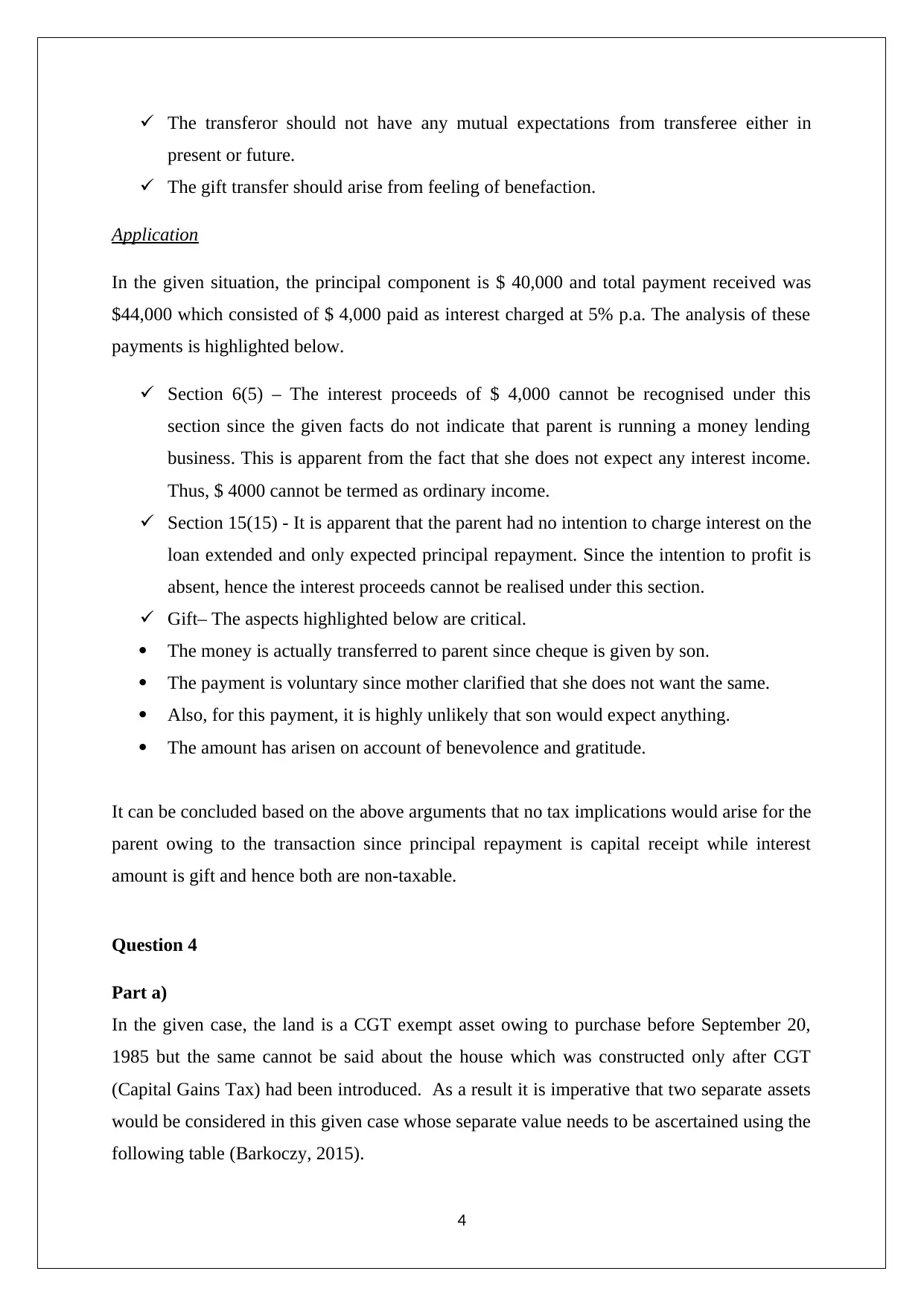
The transferor should not have any mutual expectations from transferee either in
present or future.
The gift transfer should arise from feeling of benefaction.
Application
In the given situation, the principal component is $ 40,000 and total payment received was
$44,000 which consisted of $ 4,000 paid as interest charged at 5% p.a. The analysis of these
payments is highlighted below.
Section 6(5) – The interest proceeds of $ 4,000 cannot be recognised under this
section since the given facts do not indicate that parent is running a money lending
business. This is apparent from the fact that she does not expect any interest income.
Thus, $ 4000 cannot be termed as ordinary income.
Section 15(15) - It is apparent that the parent had no intention to charge interest on the
loan extended and only expected principal repayment. Since the intention to profit is
absent, hence the interest proceeds cannot be realised under this section.
Gift– The aspects highlighted below are critical.
The money is actually transferred to parent since cheque is given by son.
The payment is voluntary since mother clarified that she does not want the same.
Also, for this payment, it is highly unlikely that son would expect anything.
The amount has arisen on account of benevolence and gratitude.
It can be concluded based on the above arguments that no tax implications would arise for the
parent owing to the transaction since principal repayment is capital receipt while interest
amount is gift and hence both are non-taxable.
Question 4
Part a)
In the given case, the land is a CGT exempt asset owing to purchase before September 20,
1985 but the same cannot be said about the house which was constructed only after CGT
(Capital Gains Tax) had been introduced. As a result it is imperative that two separate assets
would be considered in this given case whose separate value needs to be ascertained using the
following table (Barkoczy, 2015).
4
present or future.
The gift transfer should arise from feeling of benefaction.
Application
In the given situation, the principal component is $ 40,000 and total payment received was
$44,000 which consisted of $ 4,000 paid as interest charged at 5% p.a. The analysis of these
payments is highlighted below.
Section 6(5) – The interest proceeds of $ 4,000 cannot be recognised under this
section since the given facts do not indicate that parent is running a money lending
business. This is apparent from the fact that she does not expect any interest income.
Thus, $ 4000 cannot be termed as ordinary income.
Section 15(15) - It is apparent that the parent had no intention to charge interest on the
loan extended and only expected principal repayment. Since the intention to profit is
absent, hence the interest proceeds cannot be realised under this section.
Gift– The aspects highlighted below are critical.
The money is actually transferred to parent since cheque is given by son.
The payment is voluntary since mother clarified that she does not want the same.
Also, for this payment, it is highly unlikely that son would expect anything.
The amount has arisen on account of benevolence and gratitude.
It can be concluded based on the above arguments that no tax implications would arise for the
parent owing to the transaction since principal repayment is capital receipt while interest
amount is gift and hence both are non-taxable.
Question 4
Part a)
In the given case, the land is a CGT exempt asset owing to purchase before September 20,
1985 but the same cannot be said about the house which was constructed only after CGT
(Capital Gains Tax) had been introduced. As a result it is imperative that two separate assets
would be considered in this given case whose separate value needs to be ascertained using the
following table (Barkoczy, 2015).
4
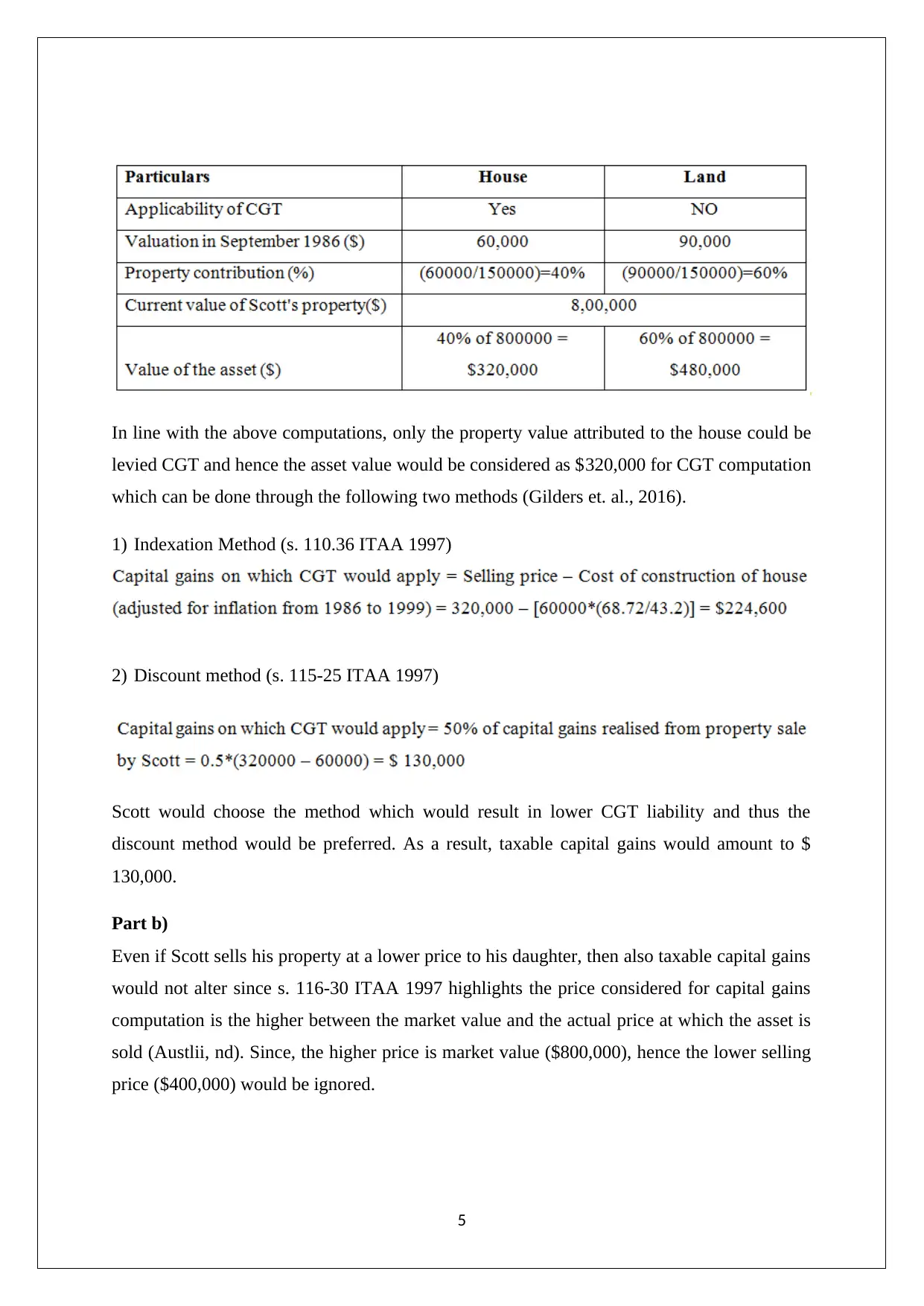
In line with the above computations, only the property value attributed to the house could be
levied CGT and hence the asset value would be considered as $320,000 for CGT computation
which can be done through the following two methods (Gilders et. al., 2016).
1) Indexation Method (s. 110.36 ITAA 1997)
2) Discount method (s. 115-25 ITAA 1997)
Scott would choose the method which would result in lower CGT liability and thus the
discount method would be preferred. As a result, taxable capital gains would amount to $
130,000.
Part b)
Even if Scott sells his property at a lower price to his daughter, then also taxable capital gains
would not alter since s. 116-30 ITAA 1997 highlights the price considered for capital gains
computation is the higher between the market value and the actual price at which the asset is
sold (Austlii, nd). Since, the higher price is market value ($800,000), hence the lower selling
price ($400,000) would be ignored.
5
levied CGT and hence the asset value would be considered as $320,000 for CGT computation
which can be done through the following two methods (Gilders et. al., 2016).
1) Indexation Method (s. 110.36 ITAA 1997)
2) Discount method (s. 115-25 ITAA 1997)
Scott would choose the method which would result in lower CGT liability and thus the
discount method would be preferred. As a result, taxable capital gains would amount to $
130,000.
Part b)
Even if Scott sells his property at a lower price to his daughter, then also taxable capital gains
would not alter since s. 116-30 ITAA 1997 highlights the price considered for capital gains
computation is the higher between the market value and the actual price at which the asset is
sold (Austlii, nd). Since, the higher price is market value ($800,000), hence the lower selling
price ($400,000) would be ignored.
5
⊘ This is a preview!⊘
Do you want full access?
Subscribe today to unlock all pages.

Trusted by 1+ million students worldwide
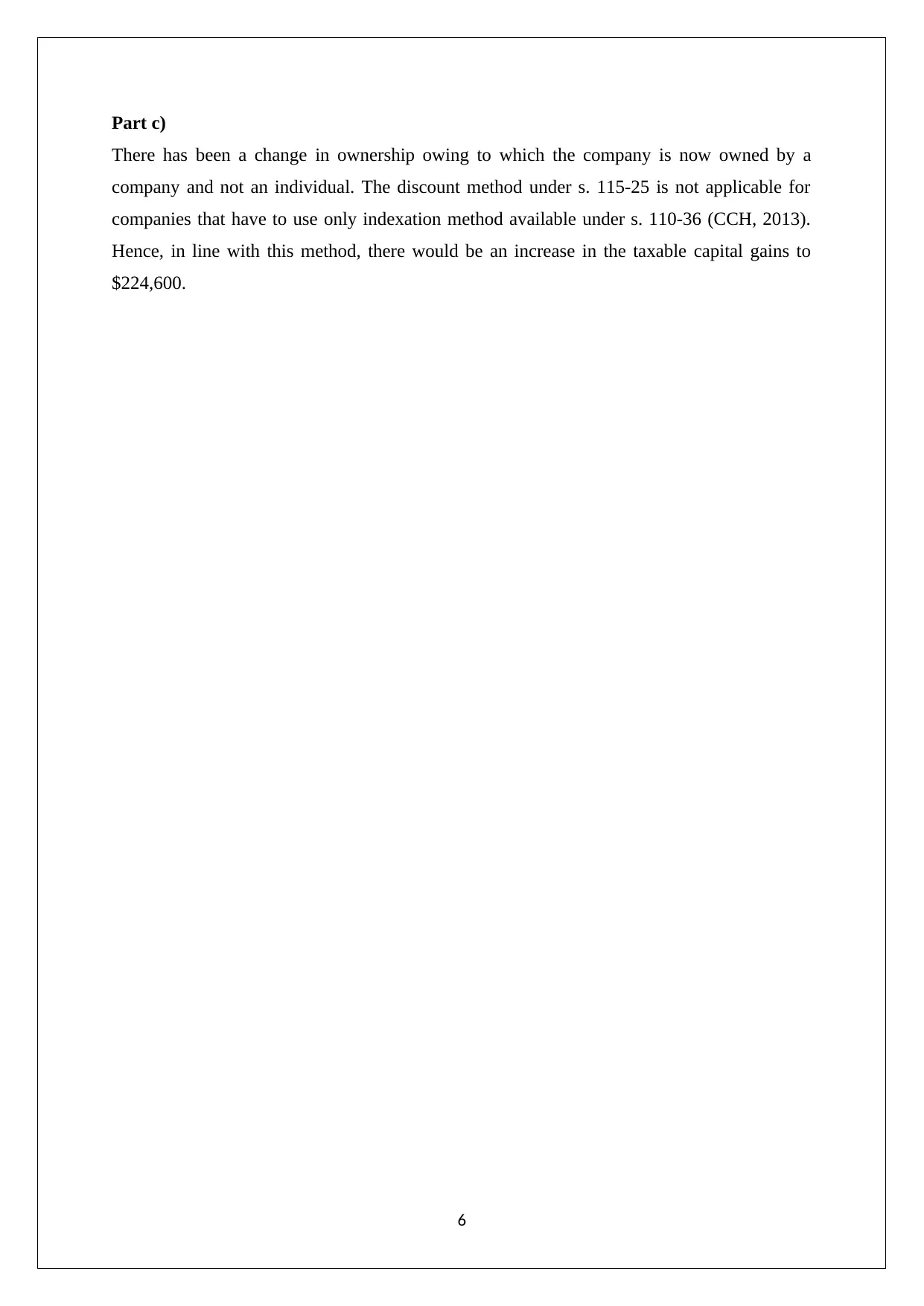
Part c)
There has been a change in ownership owing to which the company is now owned by a
company and not an individual. The discount method under s. 115-25 is not applicable for
companies that have to use only indexation method available under s. 110-36 (CCH, 2013).
Hence, in line with this method, there would be an increase in the taxable capital gains to
$224,600.
6
There has been a change in ownership owing to which the company is now owned by a
company and not an individual. The discount method under s. 115-25 is not applicable for
companies that have to use only indexation method available under s. 110-36 (CCH, 2013).
Hence, in line with this method, there would be an increase in the taxable capital gains to
$224,600.
6
Paraphrase This Document
Need a fresh take? Get an instant paraphrase of this document with our AI Paraphraser
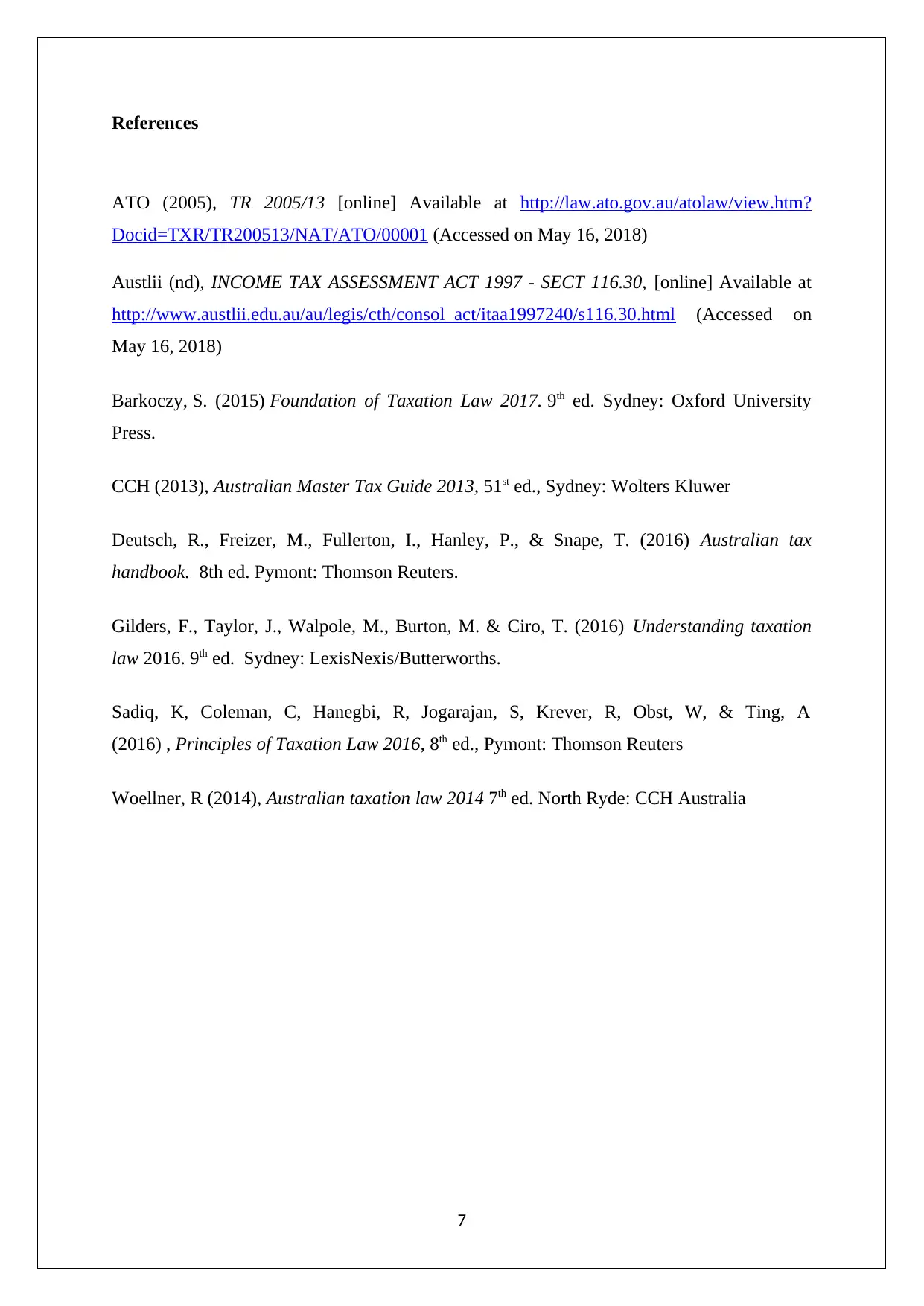
References
ATO (2005), TR 2005/13 [online] Available at http://law.ato.gov.au/atolaw/view.htm?
Docid=TXR/TR200513/NAT/ATO/00001 (Accessed on May 16, 2018)
Austlii (nd), INCOME TAX ASSESSMENT ACT 1997 - SECT 116.30, [online] Available at
http://www.austlii.edu.au/au/legis/cth/consol_act/itaa1997240/s116.30.html (Accessed on
May 16, 2018)
Barkoczy, S. (2015) Foundation of Taxation Law 2017. 9th ed. Sydney: Oxford University
Press.
CCH (2013), Australian Master Tax Guide 2013, 51st ed., Sydney: Wolters Kluwer
Deutsch, R., Freizer, M., Fullerton, I., Hanley, P., & Snape, T. (2016) Australian tax
handbook. 8th ed. Pymont: Thomson Reuters.
Gilders, F., Taylor, J., Walpole, M., Burton, M. & Ciro, T. (2016) Understanding taxation
law 2016. 9th ed. Sydney: LexisNexis/Butterworths.
Sadiq, K, Coleman, C, Hanegbi, R, Jogarajan, S, Krever, R, Obst, W, & Ting, A
(2016) , Principles of Taxation Law 2016, 8th ed., Pymont: Thomson Reuters
Woellner, R (2014), Australian taxation law 2014 7th ed. North Ryde: CCH Australia
7
ATO (2005), TR 2005/13 [online] Available at http://law.ato.gov.au/atolaw/view.htm?
Docid=TXR/TR200513/NAT/ATO/00001 (Accessed on May 16, 2018)
Austlii (nd), INCOME TAX ASSESSMENT ACT 1997 - SECT 116.30, [online] Available at
http://www.austlii.edu.au/au/legis/cth/consol_act/itaa1997240/s116.30.html (Accessed on
May 16, 2018)
Barkoczy, S. (2015) Foundation of Taxation Law 2017. 9th ed. Sydney: Oxford University
Press.
CCH (2013), Australian Master Tax Guide 2013, 51st ed., Sydney: Wolters Kluwer
Deutsch, R., Freizer, M., Fullerton, I., Hanley, P., & Snape, T. (2016) Australian tax
handbook. 8th ed. Pymont: Thomson Reuters.
Gilders, F., Taylor, J., Walpole, M., Burton, M. & Ciro, T. (2016) Understanding taxation
law 2016. 9th ed. Sydney: LexisNexis/Butterworths.
Sadiq, K, Coleman, C, Hanegbi, R, Jogarajan, S, Krever, R, Obst, W, & Ting, A
(2016) , Principles of Taxation Law 2016, 8th ed., Pymont: Thomson Reuters
Woellner, R (2014), Australian taxation law 2014 7th ed. North Ryde: CCH Australia
7
1 out of 8
Related Documents
Your All-in-One AI-Powered Toolkit for Academic Success.
+13062052269
info@desklib.com
Available 24*7 on WhatsApp / Email
![[object Object]](/_next/static/media/star-bottom.7253800d.svg)
Unlock your academic potential
Copyright © 2020–2025 A2Z Services. All Rights Reserved. Developed and managed by ZUCOL.




